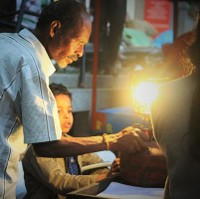Kerosene subsidies slow transition to clean energy

(cc) Flickr user bluelotus92
Billions of people around the world rely on polluting and inefficient kerosene lamps for household lighting. Yet transitioning away from kerosene and reducing the associated impacts is more complicated than simply supplying an electricity connection, since many families supplement unreliable or inadequate electric lights with kerosene lamps, according to the study, which was published today in the journal Environmental Research Letters.
“Subsidies for kerosene persist despite a growing body of evidence that it poses health risks. These subsidies are also a financially inefficient way to provide a low level of energy service.” says Nicholas Lam, the study lead author. Lam is a postdoctoral researcher at the University of Illinois in the USA, and started the work as part of the IIASA Young Scientists Summer Program (YSSP).
“We wanted to understand characteristics of families relying on kerosene and the benefits of its replacement, in order to propose better strategies for transitioning to cleaner alternatives.”
The study focused on India, because a high percentage of households there continue to use subsidized kerosene—380 million people used kerosene as their primary lighting source in India in 2011. According to the study, however, 64% of kerosene used for lighting is as a supplemental source on top of electricity, which means that simply increasing electricity access without improving reliability will make only a small dent in the amount of kerosene used.
Instead, the study shows that eliminating subsidies by 2030 could reduce kerosene use in the country by 97%, modestly improving health: such a reduction could avert between 270,000 and 300,000 disability adjusted life years, a measure of population health that refers to the number of years of life lost due to bad health, disability, or early death.
Phasing out subsidies would benefit the economy as well, since the present deadweight loss—a measure of economic inefficiency—of the subsidy is estimated at $200–950 million. The researchers point out that in order to maintain lighting access at the same time as reducing kerosene use, a rapid spread of affordable alternatives would be needed.
“Supplemental lighting is important—it makes it possible for people to study and work when they don’t have electricity or the electricity is unreliable. People use kerosene because it’s cheap and available, but this has adverse impacts for health and the environment.
The obvious solution is to shift subsides towards improving electricity reliability and cleaner lighting technologies,” explains IIASA researcher Shonali Pachauri, who worked on the study and advised Lam during the YSSP.
Reference
Lam N, Pachauri S, Purohit P, Nagai Y, Bates MN, Cameron C, Smith K. (2016). Kerosene subsidies for household lighting in India: what are the impacts? Environmental Research Letters. 11 (2016) 044014. doi:10.1088/1748-9326/11/4/044014
Media Contact
More Information:
http://www.iiasa.ac.atAll latest news from the category: Power and Electrical Engineering
This topic covers issues related to energy generation, conversion, transportation and consumption and how the industry is addressing the challenge of energy efficiency in general.
innovations-report provides in-depth and informative reports and articles on subjects ranging from wind energy, fuel cell technology, solar energy, geothermal energy, petroleum, gas, nuclear engineering, alternative energy and energy efficiency to fusion, hydrogen and superconductor technologies.
Newest articles

A blueprint for mapping melting ice sheets
Researchers in the Stanford Radio Glaciology lab use radio waves to understand rapidly changing ice sheets and their contributions to global sea-level rise. This technique has revealed groundwater beneath Greenland,…

Water hyacinth plant pots – utilization of an invasive species
Together with Fiber Engineering GmbH, the DITF presents a process for the production of biodegradable plant pots. The products are cost effective and competitive. At the same time, the production…

Current research on the new 6G mobile communications standard
Nursing care robots, autonomous driving, digital twins: all of these high-tech applications will play an essential role for the new 6G mobile communications standard. The first commercial 6G networks are…



